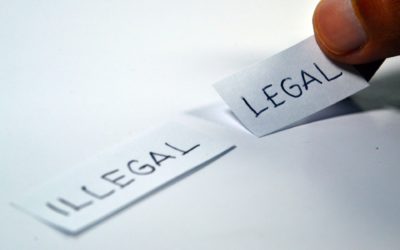Domain name registration: myth or reality?
Un nom de domaine peut revêtir une certaine valeur patrimoniale, et certains cybersquatters l’ont bien compris, en achetant à bas prix des noms de domaine dans l’unique but de les revendre, soit à un titulaire de marque n’ayant pas encore enregistré son nom de domaine, soit à toute personne pouvant y être intéressés. C’est la règle du « premier arrivé, premier servi »
Dès lors, et dans la mesure où l’article 2284 du code civil dispose « Quiconque s’est obligé personnellement, est tenu de remplir son engagement sur tous ses biens mobiliers et immobiliers, présents et à venir. » nous sommes en droit de nous interroger sur l’éventuelle saisissabilité d’un nom de domaine.
Before studying the possibility of a domain name entry, it is necessary to carry out an analysis of :
What are the assets subject to seizure?
L’article L112-1 du code des procédures civiles d’exécution précise que « les saisies peuvent porter sur tous les biens appartenant au débiteur « . Dès lors, et dans la mesure où des biens incorporels sont saisissables (article L231-1 CPCE), il convient de s’interroger sur ce qu’est un nom de domaine. Avant cela, rappelons que l’article L112-2 du même code prévoit quels sont les biens qui ne sont pas saisissables, le nom de domaine d’un site Internet n’y est pas cité.
What is a domain name?
Technically, a domain name is a sequence of characters (e.g. leroi-associes) coupled with an extension, which can be .fr, .com etc. It is a comprehensible string that replaces an IP (Internet Protocol) address and with which it is associated.
Originally, this address was made up of four groups of numbers separated by dots, different and unique for each computer, allowing it to be located physically and to share data with it via the network.
In the 1980s, the Domain Name System (DNS) was created with the aim of replacing the sequence of numbers in a computer's IP address with a sequence of characters forming a word that is understandable and easily memorable to a human mind.
The holder of a domain name reserves and purchases a domain name from a registrar, i.e. a body accredited by the competent authorities for the allocation and management of Internet domain names, approved by ICANN (Internet Assigned Numbers Authority).
Therefore, one could think that there is a transfer of ownership to the registrant (the new domain name holder) who is therefore the real owner of a domain name.
However, does a domain name have all the characteristics of a tangible personal property and can one have a right of ownership on a domain name?
All the difficulty is indeed linked to the legal nature of the :
The legal nature of a domain name
We have already seen in previous articles that intangible personal property is seizable. This is the case for shares in companies, but also for trademarks, liquor licences and taxi licences.
In the commercial context, the domain name is an intangible element of the :
It is in fact a distinctive sign that can attract customers, but it is not a trademark since the domain name is not linked to specific goods or services. In fact, the domain name is closer to the brand name than to the trademark; this is what the Paris Court of First Instance ruled on April 8, 2005 in a case called soldeurs.com , by subjecting the domain name to the same requirements as those to which brand names are subject.
The law of 22 March 2011 modified the first come, first served rule and the ordinance of 12 March 2014 completed this modification. Article L45 of the Postal and Electronic Communications Code is now worded as follows:
Domain names shall be allocated and managed in the public interest according to non-discriminatory and transparent rules, guaranteeing respect for freedom of communication, freedom of enterprise and intellectual property rights.
Domain names are allocated for a limited and renewable period.
Subject to the provisions of Article L. 45-2, the domain name shall be allocated to the eligible applicant who is the first to send in his application. A domain name that has been allocated and is still valid may not be the subject of a new application for registration.
The registration of domain names is carried out on the basis of the declarations made by the applicant and under his responsibility.
It should be noted that domain names are assigned in the general interest and therefore domain names may not be assigned. Above all, however, domain names are allocated for a limited and renewable period of time.
Definition of the right of ownership with regard to the domain name
The right to property is defined by article 544 of the Civil Code as "the right to enjoy and dispose of things in the most absolute manner provided that no use is made of them that is prohibited by laws or regulations".
The holder of a domain name seems indeed to have the right to enjoy the domain name in an absolute way: he can use it, and associate it to a use of his choice, as long as he does not make a prohibited use of it (such was for example the case of the domain name seen above: soldeurs.com which used the word solde, which is prohibited for commercial signs.
Ownership of a domain name complies with the definition of the right of ownership as defined by Article 544 of the Civil Code.
Attributes of ownership
The right of ownership has three attributes: usus, fructus and abusus.
* usus consists of the right to use the thing
* the fructus in the right to benefit from it
* abuse is the right to dispose of it (to sell it for example)
Therefore, a domain name has all three attributes of ownership.
Characteristics of the right of ownership :
The right of ownership is, in principle, absolute, individual and perpetual.
Absolute: the owner can do what he wants with the property: he can use it as he pleases, he can sell it or even destroy it, within the limit of the prohibited use referred to in section 544.
Individual (or exclusive): a property can in principle have only one owner.
Perpetual: the right of ownership exists as long as the property exists. It is passed on to the heirs on the death of the owner.
Si la propriété d’un nom de domaine possède les caractères d’absolutisme et d’exclusivité, rappelons que l’article L45 du code des Postes et des communications électroniques dispose notamment que « Les noms de domaine sont attribués pour une durée limitée et renouvelable. »
Therefore, we are faced with a difficulty insofar as the ownership of a domain name does not seem to respond to the perpetual nature of the right of ownership.
The perpetuity of ownership carries two consequences:
- there is no term to the duration of the ownership right
- the right of ownership does not become statute-barred by non-use
It could therefore be argued that the absence of perpetuity is an obstacle to the legal qualification of ownership with respect to a domain name. However, there are several exceptions to this principle of perpetuity, including copyright: Indeed, copyright falls into the public domain 70 years after the author's death.
It should also be noted that the property right granted to the holder of a patent is valid for 20 years.
As far as the domain name is concerned, Article L45 of the French Postal and Electronic Communications Code provides in any case that the right is renewable, so that the holder does not lose it. Consequently, the mere absence of the perpetual nature of a domain name does not seem to rule out the qualification of ownership right.
However, Article 2227 of the Civil Code provides that the right of ownership is imprescriptible. This means, in particular, that the right of ownership is not lost by the non-use of the thing. But what exactly is the situation with regard to domain names? Is an unused domain name protected? This is an important question, as it is common to hear that an untapped domain name is not protected.
In reality, there is no legal protection of the domain name, strictly speaking, if it has not been registered as a trademark.
The only protection of a domain name which is conditional on its exploitation consists in not allowing the holder of an unexploited domain name to oppose the exploitation by another person of a similar domain name reserved subsequently.
The mere non-use of a domain name is therefore not enough to deprive its owner of his right to his own domain name. The perpetual nature of the right of ownership is well respected.
In short, the holder of a domain name is indeed the owner of a property right on his domain name, which is, in a commercial context, assimilated to a sign.
Let's get rid of the idea that the fact of having to pay a fee to keep one's domain name would make it a kind of rental or usage right. This cannot be the case because the domain name only exists because of the will of its first owner to create it: the authority competent for the attribution and management of a domain name is not the owner since the domain name does not exist without the will of the initial registrant.
Consequently, since the holder of a domain name is granted a real right of ownership over the domain name, the domain name is indeed an intangible asset that forms part of his patrimony. With regard to Article 2284 of the Civil Code, the domain name seems to us to be a movable intangible asset that can be seized.
What is the procedure for entering the domain name?
As we have seen, the domain name is composed of a character string and an extension. The extensions (.com, .net, .fr but also .biz etc.) are managed by various authorities.
Pour faire simple, concentrons-nous sur l’autorité française pour le nommage internet en coopération (Afnic) qui est, selon son site internet une « association à but non lucratif et gestionnaire historique du .fr,opérateur multi-registres au service des domaines de premier niveau correspondant au territoire national (.fr et ultramarines) et de plusieurs projets français de nouvelles extensions Internet.
The Afnic is the registrar designated by the State for the management of domain names under the . fr domain. It also manages the overseas domains . re (Reunion Island), . pm (Saint-Pierre and Miquelon), . tf (French Southern and Antarctic Territories), . wf (Wallis and Futuna), .yt (Mayotte).
With regard to the actual seizure, as this is a non-codified procedure, and for good reason, the seizure of a domain name must be artificially created. This is moreover the case of most seizures of intangible property, which are not codified. Thus, seizures of parking permits (taxi licences), licences for drinking establishments, for example, have been created by practice and doctrine, and then validated by case law.
The Court of Cassation, in an opinion of 8 February 1999 (bull civ n° 1, D 1999 287), has indeed validated the principle of the seizability of an intangible right (in this case a licence for a public house), in the form of a procedure for the seizure of shareholders' rights and securities. Numerous cases have subsequently validated this principle for other intangible rights.
Consequently, the procedure for the attachment of shareholder rights and securities should be adapted and transposed (in the same terms as in the abovementioned notice) to the attachment of domain names.
We are not going to develop the procedure in question here, but quickly brush it off, as we imagine it to be. As we imagine it because, to our knowledge, this seizure of domain names has never been carried out in France within the framework of a civil enforcement procedure:
- La saisie débute par une saisie entre les mains du tiers émetteur. Là débute la première difficulté : qui est l’émetteur du nom de domaine ? L’Afnic ou bien le bureau d’enregistrement ? Le bureau d’enregistrement (ou registrar) est en effet l’intermédiaire obligatoire entre les internautes et l’Afnic et aucune démarche ne peut être effectuée directement à l’Afnic.
Lors d’une transmission forcée d’un nom de domaine (on parle de transmission forcée si le cédant n’existe plus ou encore en cas de décision judiciaire ou de décision prise dans le cadre d’une procédure alternative de résolution des litiges (PARL), c’est le bureau d’enregistrement qui doit procéder aux démarches auprès de l’Afnic, à l’aide d’un formulaire en ligne, en cochant la case « P » et renseigner le champs 2B par un « F ». Ce n’est qu’après que l’AFNIC vérifie la validité de la demande.
Pour l’ensemble de ces raisons, qui sont plus pratiques que juridiques, il semble que la saisie doive être effectuée entre les mains du bureau d’enregistrement ayant enregistré le nom de domaine. Nous risquons d’ailleurs de nous trouver confronté à une difficulté si le bureau d’enregistrement n’est pas en France. - This seizure could be reported immediately to the Afnic at the same time as it would be reported to the debtor.
- The domain name owner then has one month to contest the seizure.
- After one month, the sale can be organized. In the case of intangible movable property, it is the bailiff who is competent to proceed with the sale.



